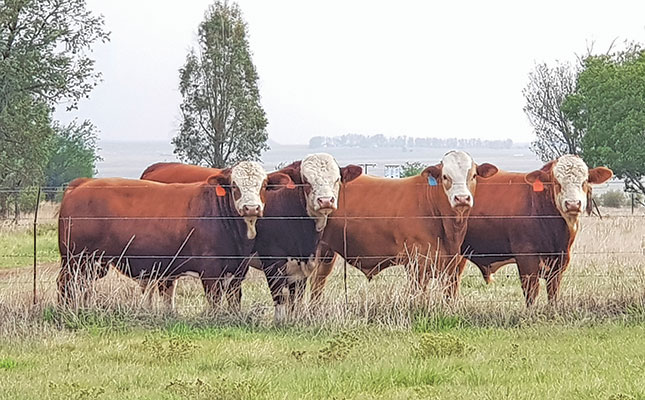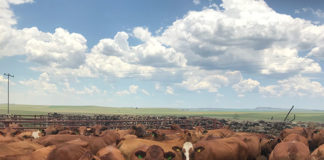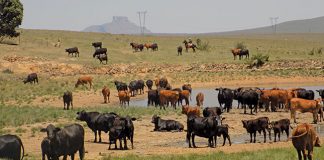
Photo: Supplied
Breeding beef cattle for greater efficiency and sustained profit is both a science and an art. But there are some basic principles of performance testing, as well as estimated breeding values (EBVs) and their use, that any beef cattle producer can implement to improve his or her herd. Some of these principles are discussed below.
1 The bigger the group of animals to test, the better
When weaning animals, weigh them all, including those being culled. If only the ‘good’ ones get weighed, the spread from light to heavy is cut off, giving a skewed picture.
2 The correct management grouping is crucial
For example, if mating groups are run separately for three months in similar pastures, then together for three or four months before weaning, they can be grouped together. If one group is fed extra, those calves and their dams are in their own management group and should be marked accordingly. If this is not done, the growth EBVs of the fed group will be inflated and will not be a true genetic value, but an environmentally influenced value. This is often the case with show animals that are not given their own management group.
3 Breeding seasons simplify performance testing and increase its accuracy
When animals are grouped in a 60- or 90-day mating and then calving period, total management, including weighing and measuring for performance traits, becomes easier. We also have bigger groups of animals together. Shorter breeding seasons also put pressure on selection for fertility.
4 A breeding objective for every stud and commercial breeder is essential
If you don’t have such an objective, performance testing as a tool will largely be a wasted exercise. If your breeding objective is fertility, ease of calving and the breeding of heavy weaners, for example, you will know to select for these desired traits and to buy bulls or rams with the desired EBVs for birth and weaning.
5 Linking bulls or rams between seasons and breeders increases the accuracy of performance testing
Rolling over some bulls between seasons and groups of females increases the accuracy of EBVs. The same applies if common bulls are used between two or three herds that do active performance testing; for example, swopping bulls between two seasons while using some of the previous season’s bulls. The more these bulls can be directly compared with each other in the same management grouping, the better.
6 Weigh and measure for all traits that your breed subscribes to
Ease of calving, calving weight, weaning, 400 day-, 600 day- and mature weights, scrotum size, sheath/navel score, carcass traits, residual feed intake and days to calving (fertility) are traits that come to mind. Some of these are correlated with one other, but don’t rely on correlations; the more you measure, the more you will know.
7 Always compare the EBVs for different traits with the breed average to see if the animal is better or worse than the breed
Some catalogues don’t show the breed averages clearly. For example, a bull may have a wean or 200-day EBV of +12 and the breed average may be +15. This means the bull is actually 3kg below the present breed average for that weight. The +15 for the breed usually means that from a certain base year, say 1993, the breed average might have been 220kg, and the breed as a whole has improved its average weaning weight by 15kg to 235kg. So the +12 bull’s weaning weight is estimated at 232kg.
8 EBVs should always be assessed together with their accuracy
Simply put, EBVs are the average genetic value of a certain trait that an animal will carry over to its progeny. Pedigree, own performance, progeny and correlations all play a role. Young bulls offered at sales don’t have progeny yet, so we have to depend on their pedigrees and own performance data. If this is in place, accuracies of above 60%, which are valuable for selection, will be reached.
When 10 or more progeny of a bull have their own data up to weaning, the accuracy of EBVs for growth traits, for example, increases dramatically, and the EBV then starts stabilising. The higher the accuracies, the more you can rely on EBVs as a selection tool. An EBV for yearling weight, based on an animal’s own performance, is shown in the following formula: EBV = (the weight of the individual) – (the average weight of all animals in the group) x heritability.
9 An EBV for a trait of an animal denotes what the average of the progeny will be for that specific trait, not how all the progeny will perform
Stud and commercial breeders often have the misconception that a bull with a high-accuracy EBV for a trait, let’s say weaning weight, indicates that all the progeny of that bull will perform similarly for that trait, but this is not the case. Quantitative genetics works on averages, as every progeny (except identical twins) will differ for certain traits due to so many gene combinations that can take place. For example, over 25 progenies of a high accuracy (80%+), the average of those progeny for, let’s say, weaning weight, will be on or very close to the average between the dam and sire’s EBV.
10 EBVs should always be used in conjunction with visual appraisal when final selection of animals takes place
When selecting a bull, look at the EBVs of the animals on offer and mark those with the desired EBVs you need for your herd. Then select one or a few of them visually. Structural correctness, muscling and masculinity in bulls, femininity in females, as well as other visual characteristics play an important role in the overall assessment of an animal. For instance, a bull or ram with excellent EBVs but with leg problems such as straight hocks and pasterns, or roll claws or weak pasterns, will not last very long and may breed the problem into your herd.
11 Rand indexes are basically an economic value put on certain EBVs for certain production systems and should be used for selection purposes if available
This could be a weaner, feedlot or grass-fed system. If your breed has these rand indexes, use the index closest to your production system to select the bulls with the higher rand indexes to buy or use. Thereafter, look at individual EBVs.
12 Genomic-enhanced estimated breeding values are on their way; they will increase the accuracies for traits
DNA testing will result in marker genes and combinations being identified for certain traits, but will not replace conventional performance recording. On the contrary, the phenotypic performance data of animals will be needed to identify which genes and gene combinations are responsible for which traits, for example growth up to weaning or fertility, or good residual feed intake.
A balanced approach
If you achieve very high weaning weights, but your herd’s mature weight is also higher, birthweight has gone up, calving ease has decreased and overall fertility has fallen, you’ve probably not progressed at all with the amount of beef produced per hectare over the long term.
The correct breeding objective can help you benefit tremendously from using accurate performance testing and utilising EBVs properly. Optimal production, not maximum production, for your farming system is the key to profitability.
Llewellyn Angus is a registered animal scientist and a South African Interbreed Judges Association examiner. He is a former president of the South African Simmentaler/Simbra Society. Email him at [email protected].











